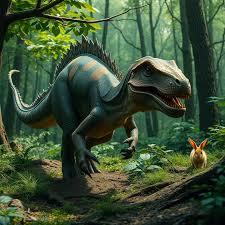Have you ever wondered what the world was like a millions of years ago? It was truly fascinating. There were early mammals, reptiles, marine life and most importantly the dinosaurs. Dinosaurs were a diverse group of reptiles that lived during the Mesozoic Era, which was split into three periods:
- Triassic period (255 to 201 million years ago)
The climate was generally hot and dry, woth vast deserts and occasional forests. Early dinosaurs began to emerge alongside other reptiles.
- Jurassic Period (201 to 145 million years ago)
This period saw a warmer, more humid climate, leading to lush vegetation. The Jurassic is known for its large dinosaurs and the first appearance of birds.
- Cretacious Period (145 to 66 million years ago)
The climate varied, with warmer temperatures leading to diverse habitats. This period witnessed the rise of flowering plants and a variety of dinosaurs. It ended with a mass extinction event.
So, dinosaurs existed for about 186 million years before their extinction, spanning from approximately 252 million years ago to 66 million years ago.
There are several theories about how dinosaurs became extinct. They are:
- Asteroid Impact: A massive asteroid struck Earth, creating the Chicxulub crater and causing catastrophic environmental changes.
- Volcanic Activity: Extensive volcanic eruptions released gases that may have led to climate change and acid rain.
- Climate Change: Gradual cooling and fluctuations in sea levels disrupted ecosystems and food sources.
- Sea Level Changes: Rising and falling sea levels affected habitats and ecosystems.
- Combination of Factors: Many scientists believe a combination of these factors contributed to the extinction.
Even after their extinction, many dinosaur fossils have been found and discoveries have been made. Scientists have gained insights into the lives of dinosaurs, including their characteristics and behaviors, as well as their habitats, diet, reproductive strategies, social interactions, and the ecosystems they inhabited. They have also uncovered evidence of their movement through fossilized footprints and discovered how some species may have communicated or displayed vibrant colors. Let's have a peak at some of the dicoveries:
- Megalosaurus: First scientifically described dinosaur, identified in 1824.
- Hadrosaurus: Nearly complete skeleton found in the 1850s, establishing dinosaurs as a distinct group.
- Dinosaur Eggs: Fossilized eggs discovered in Mongolia and China.
- Fossilized Footprints: Tracks found in various locations that provide information on movement and social behavior.
- Feathered Dinosaurs: Discoveries in China showing a link between dinosaurs and modern birds.
- Iridium Layer: Evidence of a layer linked to the asteroid impact theory for extinction.
- Dinosaur Soft Tissue: Preservation of soft tissues in fossils offering insights into biology.
- New Species: Ongoing excavations continue to identify new dinosaur species.
- Dinosaur Behavior: Findings of nesting sites revealing parental care and social interactions.
- Technological Advances: Modern methods enhancing the study of dinosaur anatomy and evolution.
What a captivating and intriguing life of dinosaurs, isn't it? The learning of dinosaurs goes on. There are still many undiscovered things about dinosaurs. Who knows, maybe in the future, you'll be the one who will expose the secrets of the dinosaurs!

